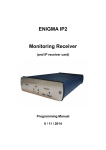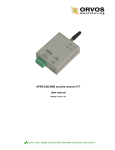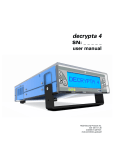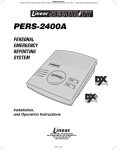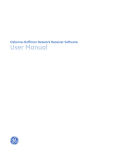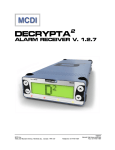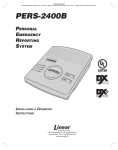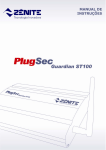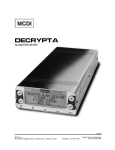Download ENIGMA II Monitoring Receiver
Transcript
ENIGMA II Monitoring Receiver Installer Manual 11 / 02 / 2014 CONTENT 1. INTRODUCTION.......................................................................................................................3 2. SYSTEM STRUCTURE.............................................................................................................3 2.1 CPM card..............................................................................................................................3 2.2 LC telephone line card (optional).........................................................................................4 2.3 RC radio receiver card (optional)..........................................................................................4 2.4 PWR power supply card.......................................................................................................4 2.5 IP card (optional)...................................................................................................................4 2.6 Monitoring software compatibility.......................................................................................5 3. FIRST STEPS..............................................................................................................................5 4. INSTALLATION.........................................................................................................................6 Mounting the receiver unit..........................................................................................................6 Printer connection.......................................................................................................................6 PC connection.............................................................................................................................6 CPM central processing card backside connectors.....................................................................7 PWR power supply card backside connectors............................................................................8 LC telephone line card backside connectors (optional)..............................................................9 RC radio receiver card backside connectors (optional)............................................................10 IP Ethernet receiver card backside connectors (optional).........................................................11 Card installation and replacement.............................................................................................12 5. TECHNICAL DATA..................................................................................................................12 2 1. INTRODUCTION Thank you for choosing our product. This modern and reliable monitoring receiver not only guarantees the highest level of security, but also it is a useful colleague in the life of every monitoring company, because of its user-friendly handling and intelligent functions. To use the highest range of provided functions please read carefully the Installer Manual. For the confident programming and secure usage please keep all warnings in Installer Manual, with highly focusing to security directions. 2. SYSTEM STRUCTURE ENIGMA II monitoring receiver provides complex and reliable solution to build up a modern monitoring station. The device can receive signals from alarm control panels through IP network, telephone line and radio channel. Due to the universal operation, the device can receive all standard (and most of the non-standard) signals from alarm control panels and communicators. With combination of an appropriate PC-based monitoring software it guarantees not only reliable signal transmission, but also easy to use operator interface. The system consists of the following devices: 2.1 CPM card Central processing card (CPM) which controls the operation of the receiver. CPM contains two serial ports (respectively 2 high speed USB ports), one Ethernet port and one parallel printer port. CPM card can store up to 2000 events in its non-volatile memory. If the connection fails with monitoring computer, the receiver stores events in its own memory, and all events will be sent automatically when the connection is restored. CPM controls the graphical LCD display as well, where received events can be seen and basic settings can be done. 3 2.2 LC telephone line card (optional) Receiver has 8 slots to connect LC telephone line cards. LC line cards can monitor one telephone line. Each telephone line card have memory to store up to 500 events or caller ID. Caller ID function is built in, the caller telephone number is stored and can be transmitted to monitoring computer. Line cards support two-way audio communication also. Line cards are continuously monitored by CPM. All line card troubles are displayed immediately at LCD display, and transmitted to monitoring computer. The line card monitors the connection with CPM as well, if it detects trouble automatically switches to standalone operation mode. In this case it continues event receiving, but stores them in its own memory. All received events will be sent automatically to CPM when the connection is restored. 2.3 RC radio receiver card (optional) The optional RC radio receiver card works as a special line card in the system – it provides event receiving through UHF radio (440..450MHz). RC card can handle two independent radio channels, which are displayed as line card “A” and “B” in the system. Event management and CPM monitoring way is similar to LC line cards. In standalone mode the RC card can store up to 500 events, which will be sent automatically to CPM when the connection is restored. 2.4 PWR power supply card PWR power supply card ensures voltage for all cards in the system. The input of PWR requires 16.5 VAC / 18 VDC, which is generated by an external transformer unit / power supply unit. PWR has got battery charging circuit, batteries can be connected to external connectors. In case of main power trouble battery powered operation is switched automatically. The capacity of batteries should be between 7 Ah and 15 Ah. The PWR continuously check the state of main power and batteries, and it reports the status to CPM unit. 2.5 IP card (optional) Receiver has 8 slots to connect IP Ethernet based receiver cards. IP cards can work in standalone mode, they control individually the incoming events through Ethernet line. Then they forward events to central processing unit through internal receiver bus. IP card gives extended range in IP receiving functions (comparing to CPM). Additionally it provides possibility to connect the system to a secondary Internet provider. 4 2.6 Monitoring software compatibility The device can work with the most generally used monitoring software packages. During development the receiver has been tested with the following software packages: • ALARM SYS (recommended), SIMS, MYMAS SURGARD receiver should be chosen for SIMS, MYMAS or other software types. 3. FIRST STEPS Please unpack the device carefully and please check is there any damage on that caused by transport. If there is any obvious damage do not switch on the device, please call the distributor. The basic package contains the following units: • ENIGMA II monitoring receiver (1 CPM card, 1 PWR card) • RS232 cable for PC connection • USB cable for PC connection • 16.5 VAC transformer and power cable / 18 VDC power supply unit • Battery connector cable (without battery) • User Manual • Programming Manual • Installer Manual Before mounting the device to its operation environment, receiver test is recommended. For this connect the external power supply to the PWR card 16.5 V AC terminals and the battery to the „BATTERY 1 +” and „BATTERY 1 –” connectors. The receiver executes a self-test after connecting the power supply and it detects system components (optional LC line cards, IP cards, RC radio receiver card). After this operation the event list can be seen on LCD display. Note: Battery usage is only recommended at BATTERY 1 connector. In special cases (usage without main power) it is possible to use two batteries (another battery on BATTERY 2 connector) to provide continuous operation, but is not recommended for long term usage. Note: Battery charging voltage can be only measured if the battery is connected. 5 4. INSTALLATION Mounting the receiver unit ENIGMA II is manufactured in a 3HE height 19” table housing. In addition it can be mounted to a standard 19” rack case by means of the holes in front board. Note: The table stands might be folded up in case of installation to a rack case. Note: LCD display is planned to be well seen in table usage. If the receiver is installed over the eye-level, it is recommended to turn a bit downward for better readability. Printer connection Any type of parallel printer can be used with Centronics connector. Connect the cable of the printer to the LPT port of the CPM unit. Note: In view of the default usage of the device, it is recommended to use matrix printer as against laser / ink-jet printers for event print. PC connection For the connection to monitoring software connect the receiver COM A (USB A) port to the serial port (USB port) of the monitoring PC. Use the cable provided in receiver package. If the cable length is not enough, you can use USB expander cable or RS232 expander cable (COM A – 2, 3, 5 pin; PC [9 pin] – 3, 2, 5 pin). With this you may have up to 10-12 m distance between receiver unit and monitoring PC. Note: COM A and USB A ports are equivalent, as the COM B and USB B ports. Do not connect devices at the same time to COM A and USB A ports. If it is possible, always recommended to use COM A as against USB A. Note: If the A serial port of the receiver has any trouble, B port can work as a replacement. For this some small configuration steps are required which can be found in Programming Manual. 6 CPM central processing card backside connectors RESET – Hardware reset button. COM A – Default communication port for PC connection. COM B – Reserve communication port for PC connection (or for external receiver). LPT – Parallel printer port. TCP/IP – Ethernet connector for IP monitoring and for remote programming. USB A – Default communication port for PC connection (if there is no serial port) USB B – Reserve communication port for PC connection. +12 V – Power connector for control functions. Up to 500 mA load capacity. PGM 1 / PGM 2 – For future usage. BUZZER – To connect external buzzer (intermittent shortcut with GND during internal buzzer activation, if the internal buzzer is enabled). Up to 50 mA load capacity. TAMPER – Works as NO tamper switch if the tamper function is enabled. EXT. ACK – Works as external acknowledge button (shortcut with GND means manual acknowledge, same way as ENTER button) if external acknowledge function is enabled. Note: Install a 10 K pull-up resistor between EXT. ACK and +12 V terminals. GND – Common GND connector for control functions. 7 PWR power supply card backside connectors For device installation connect the external voltage to the PWR card 16.5 V AC terminals and the battery to the „BATTERY 1 +” and „BATTERY 1 –” connectors. The receiver executes a self-test after connecting the power supply and it detects system components (optional LC line cards, RC radio receiver card, IP card). After this operation the event list can be seen on LCD display. Note: Battery usage is only recommended at BATTERY 1 connector. In special cases (usage without main power) it is possible to use two batteries (another battery on BATTERY 2) for continuous operation, but is not recommended for long term usage. Note: Use only the power supply (18 VDC) / transformer in receiver package (or a replacement transformer with at least 50VA @ 16.5 VAC capacity). BAT – 3.15 A – Fuse to protect battery circuit. AC – 3.15 A – Fuse to protect AC power supply circuit. BATTERY 1 – Primary battery connector (7-15 Ah). BATTERY 2 – Secondary battery connector (7-15 Ah). 16.5 V AC – Main power supply connector (18 VDC power supply / transformer in receiver package or at least 50 VA @ 16.5 VAC capacity replacement transformer). - GROUND – Standard M5 nut for grounding power supply unit. It is not allowed to use the receiver without proper grounding. Note: To provide appropriate protection against electrostatic and electromagnetic interferences the device housing should be grounded properly. Grounding of housing and grounding of telephone line cards can be connected only at the common ground point (at least 2 m distance between each card grounding point – M5 nut / terminals). Grounding is essential for flash of lighting and over-potential protection, absence of proper grounding may cause communication problems as well. Note: Never connect grounding point to receiver GND terminal, it may cause damage. 8 LC telephone line card backside connectors (optional) LC line card is suitable to receive analog (PSTN) telephone line. Connect the telephone line into the “LINE/SET” RJ11 connector at the backside of the line card. In case of ISDN line use one of the analog line outputs of ISDN NT box. For two-way audio connection the telephone set should be connected to “LINE/SET” connector also. The incoming telephone line should be connected to the two internal connector interfaces (34), telephone set should be connected to the two external connector interfaces (2-5). Pay attention that connected telephone set should be in line, as if it is in hanged up state the two-way audio connection doesn't work. Check device impedance as well – it should be 600 ohm for normal phone sets. LINE / SET – Analog telephone line connector. – GROUND – Terminals to connect telephone line card (into either of connectors). Note: Grounding of housing and grounding of telephone line cards can be connected only at the common ground point (at least 2 m distance between each card grounding point – M5 nut / terminals). Grounding is essential for flash of lighting and over-potential protection, absence of proper grounding may cause communication problems as well. 9 RC radio receiver card backside connectors (optional) RC radio receiver card can handle two independent radio channels. Channel “A” is usually supplied with built in radio (or external radio for special request). Channel “B” only can be used with an external radio unit. If the channel “A” is supplied with built in radio (RTX 2U2), only the antenna should be connected to “ANT” connector. Pay attention for using UHF antenna with suitable end of line resistor (50 ohm), and the RF cabling should have minimal loss. Note: If you want to use channel “B” with external radio unit, please contact your distributor. RSP – Radio serial port for programming without CPM (radio repeater stations), and for debugging. ANT – Antenna connector for built in radio units (channel „A”). Note: Always choose the appropriate antenna according to the installation site of the receiver. RADIO 2: External radio connector (for channel „B”). RADIO 1: For special request channel „A” might be supplied with external radio unit. 10 IP Ethernet receiver card backside connectors (optional) IP receiver cards are able to receive events through Ethernet network. IP card has extended IP receiving functions compared to CPM unit in main receiver. Connect the Ethernet network cable into the Ethernet slot on the receiver card backside. If it is required, the IP card can be connected directly to monitoring PC through USB connector on receiver backside. LAN – 100 Mbit Ethernet network connector USB – To connect monitoring PC (if it is required) 11 Card installation and replacement Receiver switch off is not required during card replacement. Unscrew the two / four fixing screws, then pull the card carefully with a firm action. New card installation is the same, only in opposite sequence. Before installing new LC / RCM / IP card, please remove the metal cover from the card position. CPM / PWR / RCM cards have fix position, LC / IP card can be mounted into 1 – 8 slots (starting from slot 1 if possible). Note: Do not forget to apply / set again previous settings (before change) in new cards. Note: If there is any malfunction after card replacement, please restart the device with F3 (UTIL) / F3 (RESET / F3 (RESET) buttons. 5. TECHNICAL DATA Product ENIGMA II Power supply 18 Vdc @ 2 A (main) or 16.5 Vac @ 30 VA (main) / 12 Vdc @ 7 Ah (battery) Maximum current consumption about 500 mA (depends on configuration) Event buffer up to 2000 events Monitored IP devices up to 255 accounts Operating temperature 10 °C / +30 °C 40% relative humidity Sizes (W / L / H) 485 x 220 x 135 mm Weight 5200 g 12












